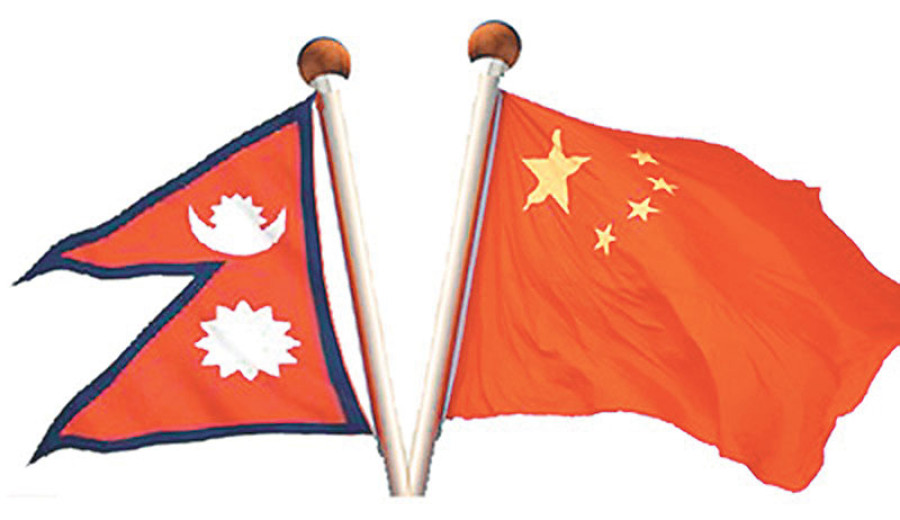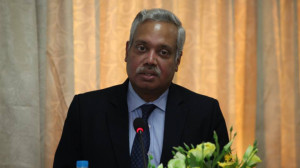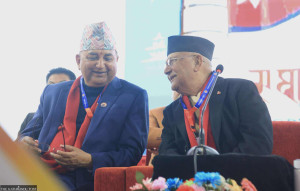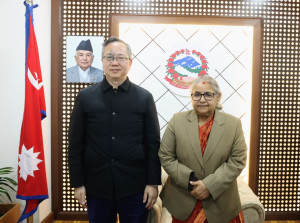National
On Nepal-China relations
This visit expects two leaders to create win-win cooperation, lasting relationship and exemplary friendship
Dinesh Bhattarai
Prime Minister KP Oli is embarking on a six-day official visit to the People’s Republic of China from June 19. China is Nepal’s close friend, trustworthy neighbour and a reliable development partner. The age-old relations were formalised on 1st August 1955. Since then they have been growing closer at the government, party and people’s level. This is the first high-level visit from Nepal to China after the installation of new government following the historic elections under the new constitution. China even applauded the promulgation of the constitution in Nepal as a historic progress in its political transition.
Nepal-China relations have stood the test of changing times and challenges. Irrespective of sizes, different political systems, level of development, and military and economic might, changes at home, region and beyond, Nepal-China relations provide an exemplary model, based as they are on the five principles of Peaceful Co-existence (Panchsheel). Nepal appreciates China’s long-standing respect for its independence, territorial integrity, stability and development.
China views this visit as an opportunity “to deepen our practical cooperation under the framework of the Belt and Road Initiative and enhance cooperation” in several areas “so as to scale our bilateral ties to a new height.” With political stability, democracy and rule of law, Chinese support to Nepal remains valuable at this juncture to create a network of infrastructures, connectivity and expedite development in areas like tourism, agriculture, hydropower, and agro-forestry among others.
Of friendship
Neighbours occupy an important place in China’s strategic management. China has launched its peripheral diplomacy that combines politics, economics and security in its relations with neighbours. China wishes to secure assurances and actions from its neighbours that no anti-Chinese activities are allowed from their territories. Nepal unequivocally maintains the One China policy and does not allow any activities against China from its territory.
Barbara W. Tuchman, in Notes from China (2017) writes, “in 1945, Mao-Tse-tung and Chou Enlai, for a working relationship with the United States, offered to come to Washington to talk in person with President Roosevelt,” the United States made no response to the overture. (p.57) On October 1, 1949, the People’s Republic of China was founded. In the 1950s and 1960s, as a professor at Duke University Bruce W. Jentleson writes: Americans did not call that large country with lots of people over Asia “China” or the “People’s Republic of China”: it was “Red China.” Nepal’s Prime Minister B.P. Koirala understood the Chinese realities and made a forceful plea while addressing the 15th UN General Assembly on 29, September 1960 to accept the People’s Republic of China as a respected member. Referring to the representation in the United Nations, he said, “In our opinion, the United Nations can neither become universal nor can it reflect the political realities existing in the world today until the People’s Republic of China is given its rightful place in the Organization. The United Nations will not be able to fulfill effectively some of its most important purposes and functions until the People’s Republic of China is brought in.” He called for “greater imagination and foresight than the United Nations has thus far shown.”
In 1960, PM Koirala wrote to Premier Chou Enlai, saying “Nepal-China friendship is of paramount importance for maintaining peace in Asia in the first instance and the world peace in the last analysis. Nepal would spare no effort to make our relations closer and stronger every day.” Subsequent developments stand as testimony to it. The roots of the present-day relations between Nepal and China go back to this period. It was then that decision was made to scientifically demarcate the boundaries and amicably settle all disputes including the ownership of Sagarmatha-the highest peak of the world in favour of Nepal, and also to open embassies in respective capitals. It is a matter of great satisfaction that Nepal and China have been working closely on issues of common interests and mutual benefit at bilateral, regional and international levels.
Balanced relations
China recognises the geopolitical realities of Nepal and wants Kathmandu to maintain good relations with India. Chinese leadership is on record to have advised Nepal to be “friendly with India without being hostile to China.” China has consistently maintained this position with regard to Nepal’s relations with India. Nepal’s relations with neighbours and wider international community are independent of each other. Nepal judges every issue on its merit and takes positions in the larger interest of the country.
In March 2016 during PM Oli’s first visit to China, Nepal and China signed landmark agreements including the trade and transit treaty—the foundation for which was laid, and documents exchanged between the two governments in 2000, during the time of Nepali Congress led government. Nepal formally joined the Belt and Road Initiative with the signing of a memorandum of understanding in May 2017 under the NC-Maoist Center coalition government. The agreements on construction of Syafrubesi-Kiyrong highway-the second highway linking Nepal with China and agriculture cooperation were two of the seven agreements signed in Kathmandu during the visit of Chinese Premier Zhu Rongji to Nepal in May 2001. Details of projects under BRI, and other agreements then signed and modalities for implementation of these projects with Chinese investments should be worked out during the current visit.
A success story
China’s economic transformation has been the success story of the twentieth century. The opening up and economic reforms launched by Deng Xiaoping have had far reaching impact on China’s diplomatic, economic and military strength. Recent developments in diplomacy in Asia, including the Singapore summit between the United States and North Korea and China’s stands on these issues carry huge implications for Asian and global geopolitics. These developments should be analysed in an integrated reality in official talks with Chinese side. PM Oli must raise the issue of ballooning trade deficit with China and take decisions on remedial measures. The inclusion of Lipu-Lekh in the China-India joint statement on May 15, 2015 is a breach of Nepal’s sovereignty and territorial integrity. It may be recalled that the Sushil Koirala government had written to both China and India in 2015 drawing their attention. As a follow up to that, PM Oli must raise this with Chinese government.
Asia has emerged as ‘the world’s brightest spot for the 21st century,’ and shaper of the world destiny. China looms large in global picture, with Beijing emerging as the most influential world capital. It behoves on Nepal to think seriously, have clarity and build reliability to make meetings in Beijing meaningful for relations, beneficial for prosperity and a secure future of Nepal. In charting out a future course of China-Nepal relations in the twenty-first century, the leaders of the two countries are expected to go beyond the ritual joint statement, and adopt a vision roadmap to erect a towering edifice of a win-win cooperation, lasting relationship and exemplary friendship.
Acharya is former ambassador to China. Bhattarai is former foreign affairs advisor to former prime ministers




 18.12°C Kathmandu
18.12°C Kathmandu















